[Solved]1 10 Pts Given Following Three Transactions T2 R2 X W2 X W2 Y Consider Schedule S1 X R2 X Q37281565
 data base1. (10 pts) Given the following three transactions T2 r2(x); w2(x); w2(y) Consider the schedule S1(x);r2(x);3(y)w3(z); w2(x);w2(y): w1(z) a. Draw the precedence graph of schedule S, and label each edge with data item(s) b. Based on the precedence graph, determine whether S is conflict serializable and justify your answer. If it is serializable, specify all possible equivalent serial schedule(s). Show transcribed image text 1. (10 pts) Given the following three transactions T2 r2(x); w2(x); w2(y) Consider the schedule S1(x);r2(x);3(y)w3(z); w2(x);w2(y): w1(z) a. Draw the precedence graph of schedule S, and label each edge with data item(s) b. Based on the precedence graph, determine whether S is conflict serializable and justify your answer. If it is serializable, specify all possible equivalent serial schedule(s).
data base1. (10 pts) Given the following three transactions T2 r2(x); w2(x); w2(y) Consider the schedule S1(x);r2(x);3(y)w3(z); w2(x);w2(y): w1(z) a. Draw the precedence graph of schedule S, and label each edge with data item(s) b. Based on the precedence graph, determine whether S is conflict serializable and justify your answer. If it is serializable, specify all possible equivalent serial schedule(s). Show transcribed image text 1. (10 pts) Given the following three transactions T2 r2(x); w2(x); w2(y) Consider the schedule S1(x);r2(x);3(y)w3(z); w2(x);w2(y): w1(z) a. Draw the precedence graph of schedule S, and label each edge with data item(s) b. Based on the precedence graph, determine whether S is conflict serializable and justify your answer. If it is serializable, specify all possible equivalent serial schedule(s).
Expert Answer
Answer to 1. (10 pts) Given the following three transactions T2 r2(x); w2(x); w2(y) Consider the schedule S1(x);r2(x);3(y)w3(z); w… . . .
[Solved]1 10 Pts Given Two Strings S T Write Function Determine T Anagram S Worst Case O N Log N Q37197327

(1) (10 pts) Given two strings s and t, write a function to determine if t is an anagram of s in at worst case O(n log n) Show transcribed image text (1) (10 pts) Given two strings s and t, write a function to determine if t is an anagram of s in at worst case O(n log n)
Expert Answer
Answer to (1) (10 pts) Given two strings s and t, write a function to determine if t is an anagram of s in at worst case O(n log n… . . .
[Solved]1 10pts Given Image Twinsnoisetif Write Matlab Python Script Accomplish Following Load Im Q37266595
 1. (10pts) Given an image ‘twins_noise.tif below. Write a MATLAB or Python script to accomplish the following: a) Load this image into a matrix and display it; b) Remove the noises in the image; c) Use thresholding (threshold is 100) to segment the image. Show transcribed image text 1. (10pts) Given an image ‘twins_noise.tif below. Write a MATLAB or Python script to accomplish the following: a) Load this image into a matrix and display it; b) Remove the noises in the image; c) Use thresholding (threshold is 100) to segment the image.
1. (10pts) Given an image ‘twins_noise.tif below. Write a MATLAB or Python script to accomplish the following: a) Load this image into a matrix and display it; b) Remove the noises in the image; c) Use thresholding (threshold is 100) to segment the image. Show transcribed image text 1. (10pts) Given an image ‘twins_noise.tif below. Write a MATLAB or Python script to accomplish the following: a) Load this image into a matrix and display it; b) Remove the noises in the image; c) Use thresholding (threshold is 100) to segment the image.
Expert Answer
Answer to 1. (10pts) Given an image ‘twins_noise.tif below. Write a MATLAB or Python script to accomplish the following: a) Load t… . . .
[Solved]1 10 Show Cyk Algorithm Following Example Cnf Grammar G B Ccib W Ababa Ababa L G 2 5 Give Q37209306

1. (10) Show the CYK Algorithm with the following example: -CNF grammar G . Bà CCIb -w is ababa. Is ababa in L(G)? 2. (5) Give a CFG for (w w a n.b n], and convert it into CNF 3. (10) Prove using pumping lemma that (w w- an.b n.c n.dAn] is not Context free 4. (10)Give the grammar for numerical expressions-operations allowed are”, /. +,-, ^. (^ is exponentiation). Symbols allowed are the operations, left and right parentheses, and “num” can be used to refer to any number. Use the standard precedence and associativity. Show transcribed image text 1. (10) Show the CYK Algorithm with the following example: -CNF grammar G . Bà CCIb -w is ababa. Is ababa in L(G)? 2. (5) Give a CFG for (w w a n.b n], and convert it into CNF 3. (10) Prove using pumping lemma that (w w- an.b n.c n.dAn] is not Context free 4. (10)Give the grammar for numerical expressions-operations allowed are”, /. +,-, ^. (^ is exponentiation). Symbols allowed are the operations, left and right parentheses, and “num” can be used to refer to any number. Use the standard precedence and associativity.
Expert Answer
Answer to 1. (10) Show the CYK Algorithm with the following example: -CNF grammar G . Bà CCIb -w is ababa. Is ababa in L(G)? 2. (… . . .
[Solved]1 12 Points Baseball Player S Batting Average Calculated Number Hits Divided Official Numb Q37283799
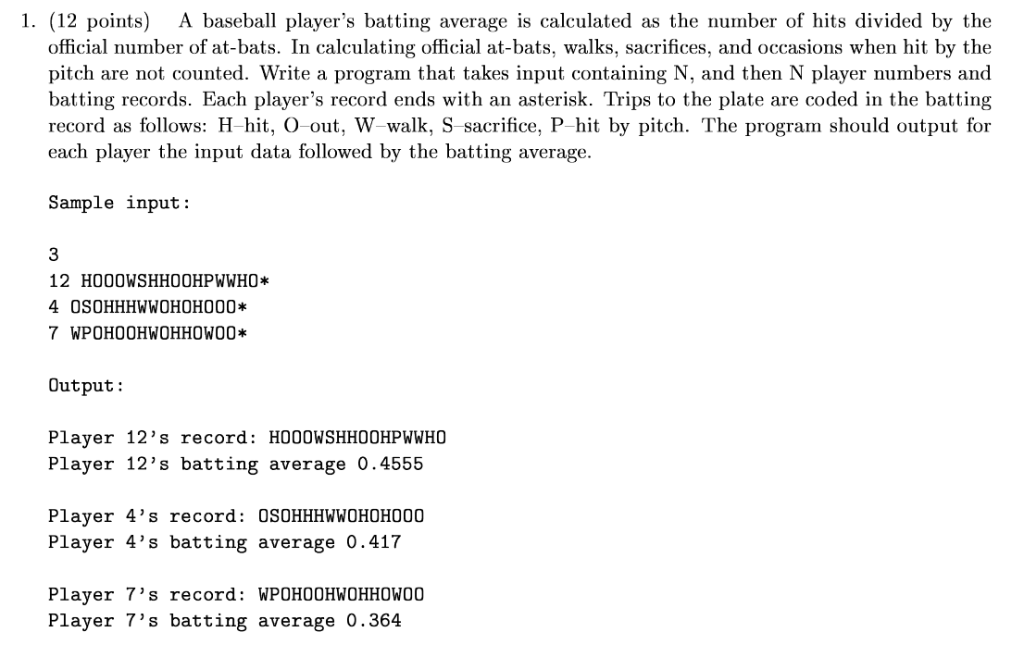
1. (12 points) A baseball player’s batting average is calculated as the number of hits divided by the official number of at-bats. In calculating official at-bats, walks, sacrifices, and occasions when hit by the pitch are not counted. Write a program that takes input containing N, and then N player numbers and batting records. Each player’s record ends with an asterisk. Trips to the plate are coded in the batting record as follows: H hit, O-out, W walk, S sacrifice, P -hit by pitch. The program should output for each player the input data followed by the batting average. Sample input: 3 12 HO00WSHHOOHPWWHO* 4 OSOHHHWWOHOHO00* 7 WPOHOOHWOHHOWO0* Output: Player 12’s record: HOOOWSHHOOHPWWHO Player 12’s batting average 0.4555 Player 4’s record: OSOHHHWWOHOH000 Player 4’s batting average 0.417 Player 7’s record: WPOH00HWOHHOWOO Player 7’s batting average 0.364 Show transcribed image text 1. (12 points) A baseball player’s batting average is calculated as the number of hits divided by the official number of at-bats. In calculating official at-bats, walks, sacrifices, and occasions when hit by the pitch are not counted. Write a program that takes input containing N, and then N player numbers and batting records. Each player’s record ends with an asterisk. Trips to the plate are coded in the batting record as follows: H hit, O-out, W walk, S sacrifice, P -hit by pitch. The program should output for each player the input data followed by the batting average. Sample input: 3 12 HO00WSHHOOHPWWHO* 4 OSOHHHWWOHOHO00* 7 WPOHOOHWOHHOWO0* Output: Player 12’s record: HOOOWSHHOOHPWWHO Player 12’s batting average 0.4555 Player 4’s record: OSOHHHWWOHOH000 Player 4’s batting average 0.417 Player 7’s record: WPOH00HWOHHOWOO Player 7’s batting average 0.364
Expert Answer
Answer to 1. (12 points) A baseball player’s batting average is calculated as the number of hits divided by the official number of… . . .
[Solved]1 125 Points Find Error Int Collection New Int 20 B Int Hours 8 12 16 C Int Table New Int Q37163092
![1. (1.25 points) Find the Error a. int[] collection= new int[-20]; b. int[] hours 8, 12, 16,; c. int[] table new int [10]; Sc](https://media.cheggcdn.com/media%2F514%2F514467ec-50a8-4a03-9ba3-98e72391b001%2Fphp8a25LR.png)
1. (1.25 points) Find the Error a. int[] collection= new int[-20]; b. int[] hours 8, 12, 16,; c. int[] table new int [10]; Scanner keyboard-new Scanner (System.in) for (int x = 1; x <= 10; x++) System.out.print (“Enter the next value: “) table [x] = keyboard. next int ( ) ; d. String[] names-“George”, “Susan” int totalLength0; for (int 1-0; 1 < name s . length(); i++) totalLength +names[i].length; String [ ] words { “Hello”, “Goodbye” }; System.out.println (words.toupperCase()); e. Show transcribed image text 1. (1.25 points) Find the Error a. int[] collection= new int[-20]; b. int[] hours 8, 12, 16,; c. int[] table new int [10]; Scanner keyboard-new Scanner (System.in) for (int x = 1; x
Expert Answer
Answer to 1. (1.25 points) Find the Error a. int[] collection= new int[-20]; b. int[] hours 8, 12, 16,; c. int[] table new int [10… . . .
[Solved]1 14 Points Consider 6 Node Network Shown Given Link Costs 7 5 Using Dijkstra S Algorithm Q37201836
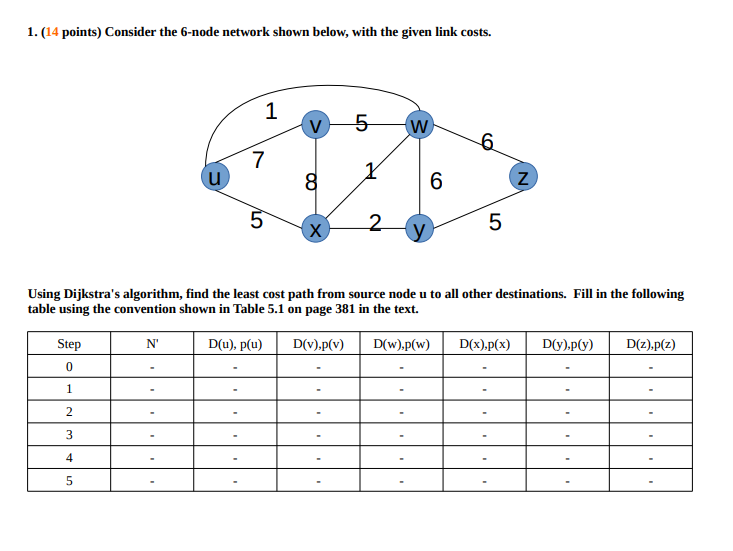
1. (14 points) Consider the 6-node network shown below, with the given link costs. 7 5 Using Dijkstra’s algorithm, find the least cost path from source node u to all other destinations. Fill in the following table using the convention shown in Table 5.1 on page 381 in the text. Step N’ D(u), p(u) D(V).p)D(w).p(w) D(x)pxDy).p(y) D(z),p(z) CD 4 Show transcribed image text 1. (14 points) Consider the 6-node network shown below, with the given link costs. 7 5 Using Dijkstra’s algorithm, find the least cost path from source node u to all other destinations. Fill in the following table using the convention shown in Table 5.1 on page 381 in the text. Step N’ D(u), p(u) D(V).p)D(w).p(w) D(x)pxDy).p(y) D(z),p(z) CD 4
Expert Answer
Answer to … . . .
[Solved]1 15 Pts Implement Recursive Memoized Dynamic Programming Fibonacci Study Performances Usi Q37204716
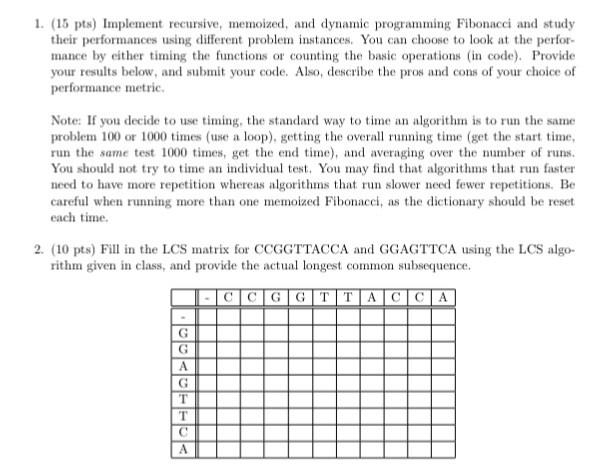 1. (15 pts) Implement recursive, memoized, and dynamic programming Fibonacci and study their performances using different problem instances. You can choose to look at the perfor- mance by either timing the functions or counting the basic operations (in code) Provide your results below, and submit your code. Also, describe the pros and cons of your choice of performance metric Note: If you decide to use timing, the standard way to tme an algorithm is to run the same problem 100 or 1000 times (use a loop), getting the overall running time (get the start time, run the same test 1000 times, get the end tme), and averaging over the number of runs. You should not try to time an ndividls You may find that algorithms that run faster need to have more repetition whereas algorithms that run slower need fewer repetitions. Be careful when running mor hanne memoized Fibonacci, as the dictionary should be reset each time, 2. (10 pts) Fill in the LCS matrix for CCGGTTACCA and GGAGTTCA using the LCS algo- rithm given in class, and provide the actual longest common subsequence Show transcribed image text 1. (15 pts) Implement recursive, memoized, and dynamic programming Fibonacci and study their performances using different problem instances. You can choose to look at the perfor- mance by either timing the functions or counting the basic operations (in code) Provide your results below, and submit your code. Also, describe the pros and cons of your choice of performance metric Note: If you decide to use timing, the standard way to tme an algorithm is to run the same problem 100 or 1000 times (use a loop), getting the overall running time (get the start time, run the same test 1000 times, get the end tme), and averaging over the number of runs. You should not try to time an ndividls You may find that algorithms that run faster need to have more repetition whereas algorithms that run slower need fewer repetitions. Be careful when running mor hanne memoized Fibonacci, as the dictionary should be reset each time, 2. (10 pts) Fill in the LCS matrix for CCGGTTACCA and GGAGTTCA using the LCS algo- rithm given in class, and provide the actual longest common subsequence
1. (15 pts) Implement recursive, memoized, and dynamic programming Fibonacci and study their performances using different problem instances. You can choose to look at the perfor- mance by either timing the functions or counting the basic operations (in code) Provide your results below, and submit your code. Also, describe the pros and cons of your choice of performance metric Note: If you decide to use timing, the standard way to tme an algorithm is to run the same problem 100 or 1000 times (use a loop), getting the overall running time (get the start time, run the same test 1000 times, get the end tme), and averaging over the number of runs. You should not try to time an ndividls You may find that algorithms that run faster need to have more repetition whereas algorithms that run slower need fewer repetitions. Be careful when running mor hanne memoized Fibonacci, as the dictionary should be reset each time, 2. (10 pts) Fill in the LCS matrix for CCGGTTACCA and GGAGTTCA using the LCS algo- rithm given in class, and provide the actual longest common subsequence Show transcribed image text 1. (15 pts) Implement recursive, memoized, and dynamic programming Fibonacci and study their performances using different problem instances. You can choose to look at the perfor- mance by either timing the functions or counting the basic operations (in code) Provide your results below, and submit your code. Also, describe the pros and cons of your choice of performance metric Note: If you decide to use timing, the standard way to tme an algorithm is to run the same problem 100 or 1000 times (use a loop), getting the overall running time (get the start time, run the same test 1000 times, get the end tme), and averaging over the number of runs. You should not try to time an ndividls You may find that algorithms that run faster need to have more repetition whereas algorithms that run slower need fewer repetitions. Be careful when running mor hanne memoized Fibonacci, as the dictionary should be reset each time, 2. (10 pts) Fill in the LCS matrix for CCGGTTACCA and GGAGTTCA using the LCS algo- rithm given in class, and provide the actual longest common subsequence
Expert Answer
Answer to 1. (15 pts) Implement recursive, memoized, and dynamic programming Fibonacci and study their performances using differen… . . .
[Solved]1 14 Points Consider 6 Node Network Shown Given Link Costs Q37200381
1. (14 points) Consider the 6-node network shown below, with thegiven link costs.
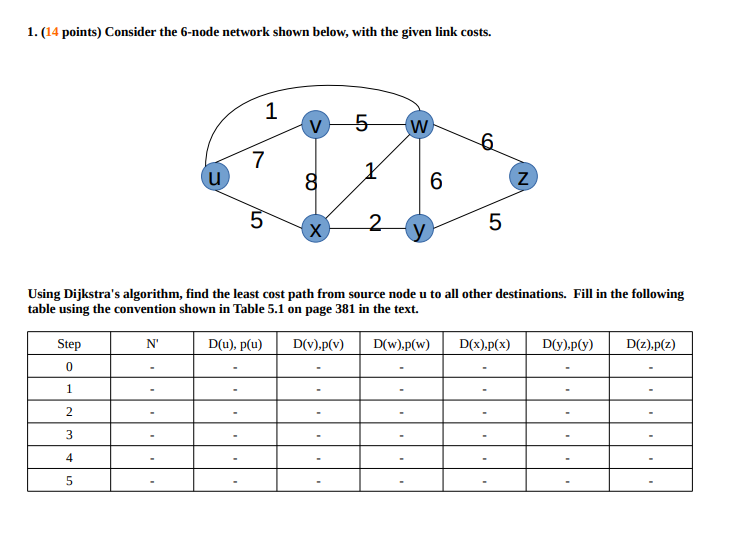
1. (14 points) Consider the 6-node network shown below, with the given link costs. 7 5 Using Dijkstra’s algorithm, find the least cost path from source node u to all other destinations. Fill in the following table using the convention shown in Table 5.1 on page 381 in the text. Step N’ D(u), p(u) D(V).p)D(w).p(w) D(x)pxDy).p(y) D(z),p(z) CD 4 Show transcribed image text 1. (14 points) Consider the 6-node network shown below, with the given link costs. 7 5 Using Dijkstra’s algorithm, find the least cost path from source node u to all other destinations. Fill in the following table using the convention shown in Table 5.1 on page 381 in the text. Step N’ D(u), p(u) D(V).p)D(w).p(w) D(x)pxDy).p(y) D(z),p(z) CD 4
Expert Answer
Answer to 1. (14 points) Consider the 6-node network shown below, with the given link costs…. . . .
[Solved]1 15 Pts Implement Recursive Memoized Dynamic Programming Fibonacci Study Performances Usi Q37232414
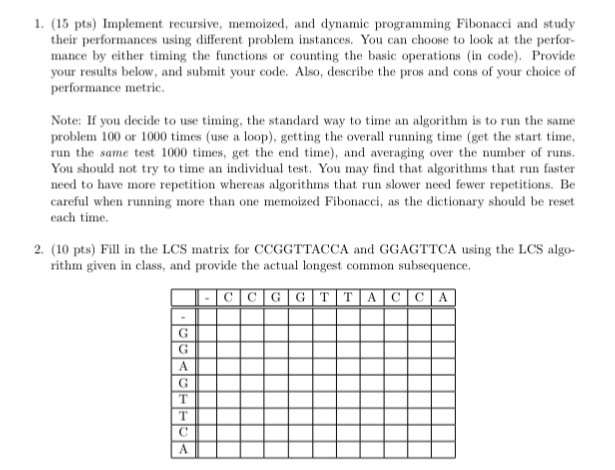 1 (15 pts) Implement recursive, memoized, and dynamic programming Fibonacci and study their performances using different problem instans You can choose to look at the perfor- mance by either timing the functions or counting the basic operations (in code) Provide your results below, and submit your code. Also, describe the pros and cons of your choice of performance metric Note: If you decide to use timing, the standard way to time an algorithm is to run the same problem 100 or 1000 times (use a loop), getting the overall running time (get the start time run the same test 1000 times, get the end ti and averaging over the number of runs. You should not try to time an individual test. You may find that algorithms that run faster need to have more repetition whereas algorithms that ru slower need fewer repetitions. Be careful when running mo hanone memoized Fibonacci, as the dictionary should be reset each time, 2. (10 pts) Fill in the LCS matrix for CCGGTTACCA and GGAGTTCA using the LCS algo- rithm given in class, and provide the actual longest common subsequence Show transcribed image text 1 (15 pts) Implement recursive, memoized, and dynamic programming Fibonacci and study their performances using different problem instans You can choose to look at the perfor- mance by either timing the functions or counting the basic operations (in code) Provide your results below, and submit your code. Also, describe the pros and cons of your choice of performance metric Note: If you decide to use timing, the standard way to time an algorithm is to run the same problem 100 or 1000 times (use a loop), getting the overall running time (get the start time run the same test 1000 times, get the end ti and averaging over the number of runs. You should not try to time an individual test. You may find that algorithms that run faster need to have more repetition whereas algorithms that ru slower need fewer repetitions. Be careful when running mo hanone memoized Fibonacci, as the dictionary should be reset each time, 2. (10 pts) Fill in the LCS matrix for CCGGTTACCA and GGAGTTCA using the LCS algo- rithm given in class, and provide the actual longest common subsequence
1 (15 pts) Implement recursive, memoized, and dynamic programming Fibonacci and study their performances using different problem instans You can choose to look at the perfor- mance by either timing the functions or counting the basic operations (in code) Provide your results below, and submit your code. Also, describe the pros and cons of your choice of performance metric Note: If you decide to use timing, the standard way to time an algorithm is to run the same problem 100 or 1000 times (use a loop), getting the overall running time (get the start time run the same test 1000 times, get the end ti and averaging over the number of runs. You should not try to time an individual test. You may find that algorithms that run faster need to have more repetition whereas algorithms that ru slower need fewer repetitions. Be careful when running mo hanone memoized Fibonacci, as the dictionary should be reset each time, 2. (10 pts) Fill in the LCS matrix for CCGGTTACCA and GGAGTTCA using the LCS algo- rithm given in class, and provide the actual longest common subsequence Show transcribed image text 1 (15 pts) Implement recursive, memoized, and dynamic programming Fibonacci and study their performances using different problem instans You can choose to look at the perfor- mance by either timing the functions or counting the basic operations (in code) Provide your results below, and submit your code. Also, describe the pros and cons of your choice of performance metric Note: If you decide to use timing, the standard way to time an algorithm is to run the same problem 100 or 1000 times (use a loop), getting the overall running time (get the start time run the same test 1000 times, get the end ti and averaging over the number of runs. You should not try to time an individual test. You may find that algorithms that run faster need to have more repetition whereas algorithms that ru slower need fewer repetitions. Be careful when running mo hanone memoized Fibonacci, as the dictionary should be reset each time, 2. (10 pts) Fill in the LCS matrix for CCGGTTACCA and GGAGTTCA using the LCS algo- rithm given in class, and provide the actual longest common subsequence
Expert Answer
Answer to 1 (15 pts) Implement recursive, memoized, and dynamic programming Fibonacci and study their performances using different… . . .

